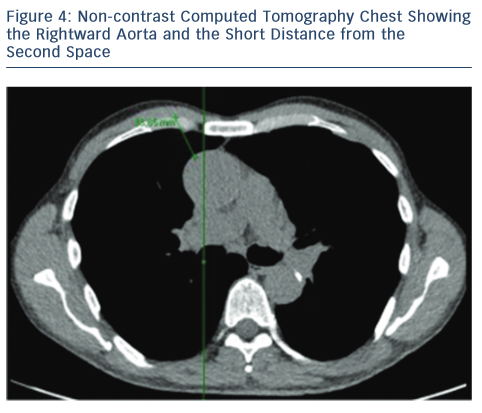Discussion
With an increased population and, in turn, life expectancy, it could be anticipated the older generation will continue to grow. The elderly patient inevitably will have multiple pathologies. Nowadays complex cases and high-risk patients need to be approached with the most recent available techniques. Over the past 2 decades minimally invasive aortic valve surgery has been gradually introduced into clinical practice. The increasing popularity for less-invasive procedures allow surgeons to perform complex cardiac interventions with the same quality even with smaller incisions. Overall, minimally invasive surgery and combined procedures or staged/hybrid procedures permits good outcomes, even in high-risk populations.25

In today’s society of patient care is expectated to be at an increasingly high standard. Moreover, patients’ requests include minimally invasive procedures. Patient choice is more contemplated, evaluated in the current practice and high on the agenda in the healthcare setting. Consultation with the patients should thus include the option of a minimally invasive approach as routine. Cardiac surgeons and cardiologists must provide the most effective treatment for their patients – as physicians we need to learn to adapt to the new changing techniques. Nevertheless, safety and quality of life of patients must never be compromised and should be the first priority above any marketing concerns. It is necessary to adopt and learn these techniques in the armamentarium of treatment of heart valve disease.26 Essential endovascular skills are necessary for cardiac surgeons, therefore close communication with an interventional cardiologist is mandatory.
The drawback for MIAVS is increased cardiopulmonary bypass and crossclamp times and is therefore technically more demanding for surgeons. The longer learning curve also can be detrimental for the adoption of these newer techniques. Despite these factors, the benefits shown in different retrospective studies are greater, such as improved cosmesis, reduced post-operative pain, reduced blood transfusion, reduced ventilator times and hospital length of stay.26 In order to reduce intraoperative times, three different sutureless or rapid deployment aortic valves have been recently introduced in Europe for use in both conventional AVR and MIAVR operations – the Enable™ Valve System (Medtronic, Minneapolis, MN, USA), the Perceval S™ Valve System (Sorin Biomedica Cardio Srl, Sallugia, Italy) and the Edwards Intuity™ Valve System (Edwards Lifesciences, Irvine, CA, US). In a recent study of patients undergoing MIAVR approach and sutureless devices, Santarpino et al. showed better outcomes in the sutureless group, suggesting that the combination of a MIAVR associated with a sutureless valve may be the first-line treatment for high-risk patients considered to be in the grey zone between TAVI and conventional surgery.27 Gilmanov et al. published a series of 515 patients undergoing RAT AVR, 269 with conventional prostheses and 246 using sutureless prostheses.28 They showed that CPB and crossclamp time was significantly shorter in the sutureless group, while peri-operative strokes, pacemaker implantations and in-hospital mortality were comparable.28 At median follow-up of 21 months, there was a twofold higher actual survival in the octogenarian patients with sutureless compared with sutured valves (100 % versus 50 %; P=0.02).28 We believe that sutureless valves and transcatheter procedures will be become more prevalent as part of everyday practice in the present and in the future.
We have already mentioned studies comparing outcomes of MIAVR with conventional AVR. However, there is little evidence comparing the outcomes of the UHS versus the RAT approach. Miceli et al. retrospectively examined AVR in 406 patients by either RAT or mini-sternotomy and found that patients who received RAT experienced reduced ventilation time (median 7 hours, interquartile range [IQR] 5–9 hours versus median 8 hours; IQR 6–12 hours; P=0.003), a lower incidence of new-onset postoperative atrial fibrillation (AF) (19.5 % versus 34.2 %; P=0.01), shorter ICU stays (median 1 day, IQR 1 day versus median 1 day, IQR 1–2 days; P=0.001) and overall hospital stays (median 5 days, IQR 5–6 days versus median 6 days, IQR 5–8 days; P=0.0001) compared with mini-sternotomy patients.29 In addition, survival at 1 year and 5 years was higher for RAT patients relative to mini-sternotomy patients (97 % and 86 % versus 94 % and 80 %; P=0.1), although the difference was not statistically significant.29 Similiarly, in a propensity score matched analysis, Hiraoka et al.29 found that RAT patients experienced fewer blood transfusions (42 % versus 67 %; P=0.025), a shorter operative time (235 ± 35 minute versus 272 ± 73 minute; P=0.009), shorter ICU stays (1.4 ± 0.8 days versus 2.2 ± 1.1 days; P=0.001) and shorter hospital stays (13.3 ± 6.5 days versus 21.5 ± 10.3 days; P=0.001, respectively) compared with partial and full sternotomy patients.30 Furthermore, patients who undergo RAT have little to no post-operative physical restrictions because the sternum is left intact and stable during surgery. This is in contrast to patients undergoing a UHS who are required to take sternal precautions after surgery. Larger, randomised controlled studies are needed to compare the efficacy and benefits of the two methods in detail.
Future techniques as robotic and video-assisted surgeries are not as distant and inaccessible techniques were in the past decades. In order for this to be achievable, more education, funding and training needs to be provided routinely. Furthermore, as clinical trials continue with transcatheter valves, if MIAVS continues to demonstrate superior outcomes compared with full sternotomy, then it should be assumed that MIAVS should be the golden standard used to compare these emerging technologies against.